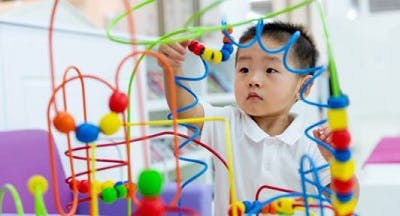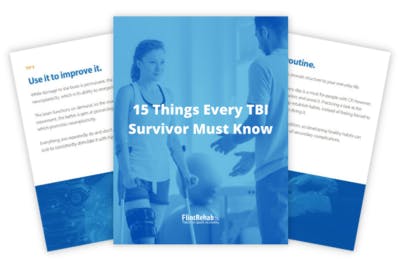No products in the cart.
No products in the cart.
No products in the cart.
No products in the cart.
Home » Neurological Recovery Blog » Traumatic Brain Injury » Life After TBI » Can a Child Recover from a Traumatic Brain Injury? What to Expect on the Road to Recovery
Last updated on April 19, 2022

Traumatic brain injury is unfortunately one of the leading causes of disability in children. This leaves many parents wondering: can a child recover from a traumatic brain injury? With the appropriate management techniques, oftentimes a child can recover from a traumatic brain injury.
While children may sustain severe traumatic brain injuries, the majority of children (up to 90%) experience mild TBIs and recover well. While each traumatic brain injury is unique, resulting in differing effects and varying recovery outcomes, pursuing rehabilitation can help children achieve an optimal recovery.
Throughout this article, we’ll discuss the following areas related to pediatric traumatic brain injury:
A traumatic brain injury refers to acquired brain damage resulting from a blow to the head or body. There are many causes of pediatric traumatic brain injuries. Falls are the most common cause of traumatic brain injury in children under age 14, often occurring on a playground.
Compared with older children, babies and toddlers are more likely to experience traumatic brain injuries due to abuse, while adolescents have a higher likelihood of sports-related injuries. Motor vehicle accidents and bicycle accidents are also common causes of pediatric TBIs.
Secondary effects of pediatric TBI vary greatly depending on the location and severity of brain damage. Children most often experience mild traumatic brain injuries, or concussions. Common effects of mild traumatic brain injury in children include:
In addition to the list above, effects of moderate or severe traumatic brain injury in children include:
Of note, some secondary effects of traumatic brain injury in infants or toddlers may not become apparent until the child develops further. Since memory, attention, language, and behavioral skills are underdeveloped in young children, deficits in these areas are often overlooked initially.
If you suspect your child may have a traumatic brain injury, it is essential to seek medical attention. Signs that you need emergency medical care include:
In addition to the above signs, infants who refuse to nurse or eat or who are crying excessively and inconsolably should also be seen immediately.
Emergency medical care is essential to ensure the brain and body are stable. This care may include testing for physical, verbal and eye gaze responses, ensuring an appropriate amount of oxygen is reaching the brain, and managing intracranial pressure.

Once a child is considered medically stable, they often are discharged home to continue their journey toward recovery. This is an excellent time to pursue therapy and other treatments to optimize a child’s recovery from traumatic brain injury.
Although the brain has been damaged, it is able to rewire itself to move affected functions to healthy areas of the brain using a process called neuroplasticity. Repetitively practicing exercises and activities related to affected functions can promote neuroplasticity and optimize recovery.
It is important to note, however, that sometimes children are unable to overcome the secondary effects of their traumatic brain injury. In this case, they are often encouraged to utilize compensatory strategies and accommodations.
Depending on the child’s age, severity of injury, and the secondary effects experienced, the following treatment techniques may be used:
Physical therapy focuses on promoting proper movement patterns, strength, balance and coordination. A physical therapist may use stretches, strengthening exercises, gait training, and hands-on techniques to help children improve their movements. They may also be able to use specialized techniques to assist with headaches and dizziness.
Occupational therapy centers around empowering children to be as independent as possible (and developmentally appropriate). They use activities and exercises focused on helping children with daily tasks, such as getting dressed, making their lunch, or writing. Occupational therapists also address sensory concerns. When children have difficulties recovering functionally, occupational therapists may encourage compensatory strategies, such as using adaptive equipment.
Speech therapy is essential not only for children who experience speech delays or impairments after TBI, but also for those with eating and cognitive difficulties. A speech therapist may use exercises to strengthen the oral motor muscles for speaking, chewing, and swallowing. Additionally, they can introduce strategies for improving cognitive skills, such as attention, problem solving, and memory.
Psychotherapy and/or social work can be helpful in learning coping techniques for emotional or behavioral changes following traumatic brain injury. They may use individual or group treatments to encourage emotional regulation and appropriate behaviors.
Depending on child’s age and needs, these treatments may be administered in the home, at an inpatient center or outpatient clinic, or in school. Professionals oftentimes try to make treatments engaging and interactive, incorporating games and challenges into interventions. This not only boosts a child’s participation in therapy, but also encourages them to perform more repetitions of affected functions, which promotes neuroplasticity.
If a child has secondary effects that affect their participation in school, they may benefit from an Individualized Education Program (IEP). This plan may include therapy services needed to succeed in a school setting, as well as accommodations that can be used in the classroom and throughout the school. Some example accommodations that children could benefit from following a traumatic brain injury include extra time on assignments or utilizing a quiet workspace in another room for tests.

While it is impossible to predict the timeline for a child to recover from a traumatic brain injury, there are some factors that come into play.
Generally, children who have less severe traumatic brain injuries are able to recover more quickly. Children often recover from mild traumatic brain injuries within weeks to months. When effects last longer than this, as is the case for 10 to 30% of children, it is referred to as persistent post-concussion syndrome. Of children with moderate or severe traumatic brain injuries, approximately 62% will experience long-term effects.
Children who sustain their injuries at a younger age often have more challenges in recovering than those who are older. Younger children are at a critical stage of brain development. Sustaining a traumatic brain injury can significantly disrupt this development, making recovery more difficult.
Many children recover from traumatic brain injury each year. Recovery outcomes vary based on severity and the child’s age at the time of injury. While not all children recover fully, pursuing therapy to promote neuroplasticity is an excellent way to optimize recovery.

If you like our content, you’ll love our ebook and newsletters! Get instant access to our TBI recovery tips ebook with 20 pages of helpful advice by signing up below.
You’ll also receive our emails that share survivor stories and more useful TBI recovery tips, which you can opt out of at any time. (We know you’ll love them, too.)
We will never sell your email address, and we never spam. That we promise.


Time with a speech therapist is extremely valuable during recovery, especially if you struggle with communication, critical thinking, or memory after brain injury. Insurance typically covers speech therapy for a fixed amount of time. But once it’s over, recovery is in your hands.
That’s why a team of neuroscientists and clinicians from Boston University created the CT Speech & Cognitive Therapy app. Designed for those recovering from stroke, TBI, or living with neurological conditions, the app contains over 100,000 cognitive exercises that are all available right from your phone or tablet. That’s like having a speech therapist by your side whenever you want!
This app is the perfect fit if you want to improve your speaking, memory, or general mental sharpness. And, it’s affordable at just $29.99/month!
“For the past 6 months, my son has used the app about three times a week. The app is like a virtual therapist, it’s very easy to use, and it gives him immediate feedback.
He now understands things faster, can make decisions with less hesitation, has improved recognition of words, and his confidence is higher. I also find it easy to get in touch with customer service; they pleasantly help out. The whole experience has been great.”
— Miriam
With the CT App, you can get the guidance you need right from your phone or tablet. You can use it on your own or in between sessions with your speech therapist.
Whether you struggle with aphasia, memory loss, or critical thinking, the CT Speech & Cognitive Therapy App can help.
“The CT app has helped me gather my confidence by building on and reinforcing old forgotten skills. It helps to see my percentages increase, and work harder when they decrease. It’s very self-motivating.” -Kathryn
We are confident that this app will help improve your speech and cognitive function after brain injury. Like our recovery tools, the CT App is also covered by our 30-day money-back guarantee.

Do you know these 15 TBI recovery tips?
Get a free copy of our ebook 15 Things Every TBI Survivor Must Know. Click here to get instant access.
Grab a free rehab exercise ebook!
Sign up to receive a free PDF ebook with recovery exercises for stroke, traumatic brain injury, or spinal cord injury below: